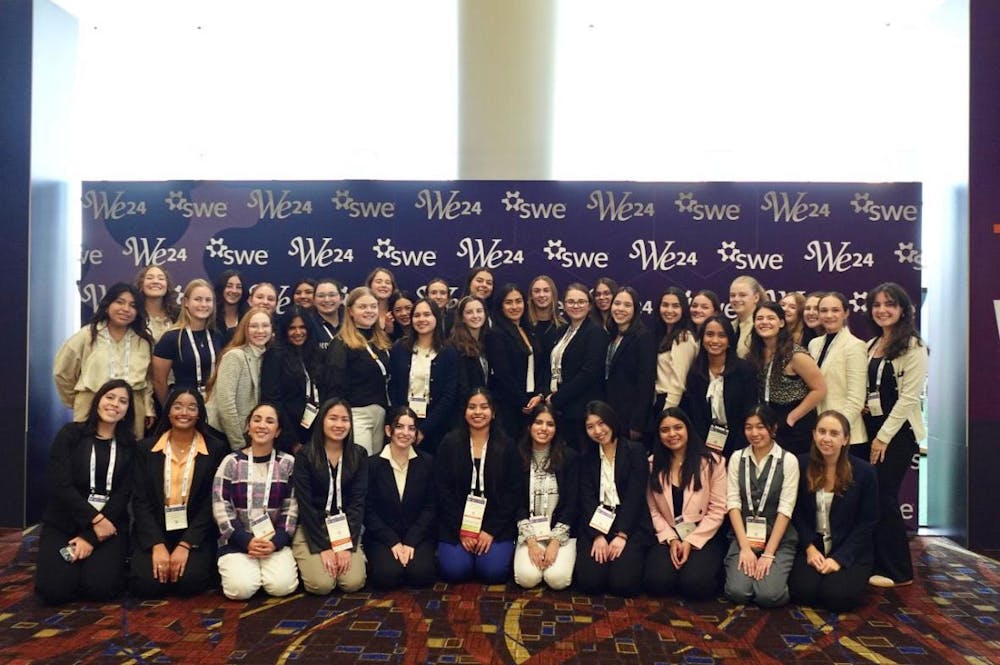Notre Dame's engineering programs have historically seen a much lower retention rate for female engineering students than for male students, according to Kerry Meyers, associate dean for student development in the College of Engineering and director of Notre Dame Women in Engineering. Now, however, the retention rates for female and male students are within 1% of each other, both around 90%.
A large contributor to this change has been an effort to cluster female engineering students in certain dorms, Meyers shared in an email to The Observer.
Residential Life works with the Center for University Advising to ensure female students who have identified engineering as their intended major are placed in specific dorms, Karen Kennedy, associate vice president for residential life, shared in another email to The Observer.
Bianca Batista, senior and vice president of operations for Notre Dame’s Society of Women Engineers, spoke on her experience living in Cavanaugh Hall, which she identified as a dorm with a high concentration of women studying engineering.
“One of the first things I noticed when I got here was that there were so many engineers in my hallway and my section,” Batista said.
“As a first-year, there were always upperclassmen in my major or engineering in general that had already taken the classes,” she continued. She noted this immediately created a STEM community and support system for her, which she otherwise would not have had when she first came to Notre Dame.
Neither Kennedy nor Meyers disclosed which women’s dorms the engineers are clustered in, but Batista noted Cavanaugh alongside Welsh Family Hall and Flaherty Hall had high concentrations. She added that she believes each quad has at least one STEM-heavy female dorm.
Lily Miller, a sophomore mechanical engineering major in Welsh Family Hall, echoed Batista’s enthusiasm for the community.
“I’ve really loved living in Welsh Fam and connecting with so many other girls in engineering, especially in my major of mechanical engineering. Especially when academics get tough, it’s motivating to be surrounded by others going through the same thing,” Miller said.
“When you ask women engineering students about their experience, they talk about how critical it is to have a community of peers in their dorm to study with (and upperclassmen who have gone before them),” Meyers wrote.
Batista expanded upon the importance of being surrounded by other engineering students, sharing that her experience would have been different had she gone through engineering without other students to look to for support.
“Providing communities for women in engineering is super important, and I do think that without the community, a lot of people would fall through the cracks or not feel like they had the support system around them to push through the barriers to being in STEM as a woman,” Batista said.
According to Kennedy, this community enables “female engineering students to easily find study groups, lab partners and other women who understand the intense focus required to succeed in engineering, while also living in community with a diversely talented group of students studying the wide variety of academic disciplines.”
Miller noted she believes the Welsh Family Hall STEM community has “given [her] access to a lot more academic and professional support than I think I would have had otherwise.”
A large factor behind the effectiveness of the cluster housing is the opportunity for upperclassmen to serve as mentors, Kennedy noted. She explained the proximity creates relationships between upperclassmen female engineering students and freshmen that enable them to provide insights into courses, internships and study abroad experiences.
On her opportunities to shift into a mentorship role while building relationships with the younger female engineering students in her dorm, Batista shared, “I’ve talked them through certain classes, helped them with homework and provided them with mentorship when they’re overcoming some of the challenges with engineering alone and being a woman in engineering.”
As of 2024, women made up 38% of students in the College of Engineering. Batista added that the gender breakdown varies greatly within the college by major, contributing to the need for mentorship in particularly male-dominated majors.
“I feel so lucky to be surrounded by so many talented female engineers in my dorm,“ Flaherty Hall freshman Lilly Nadler, who majors in mechanical engineering, said.
"Engineering in general is such a male-dominated field, but knowing that there are a multitude of supportive women engineers just down the hall that I can talk to at any point for advice or extra help allows me persevere and helps to push aside doubts that arise for me as a woman in STEM,” she added.
“The greater community is strong because it starts in the dorms and then echoes throughout classes, organizations and the college as a whole,” Batista said.
She elaborated upon the strength of the engineering program.
“It’s a very supportive program, not only due to the student-run groups, but also by the college. I've always felt recognized, supported and helped by these entities throughout my time here,” Batista said.
Meyers emphasized that while women in engineering are clustered in certain dorms, placements within the halls and roommates remain random, as all freshmen are required to live with a random roommate. She also noted that women in engineering continue to make up a minority of the hall population in the cluster dorms.










